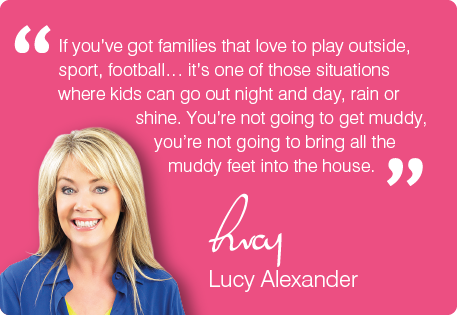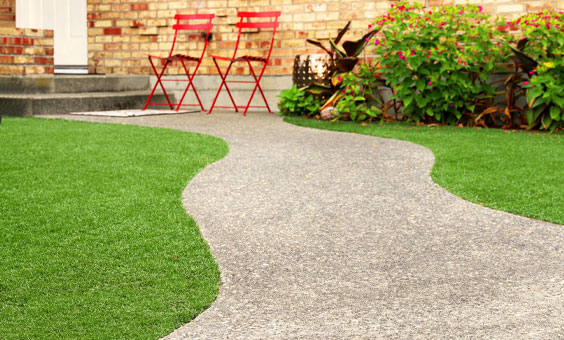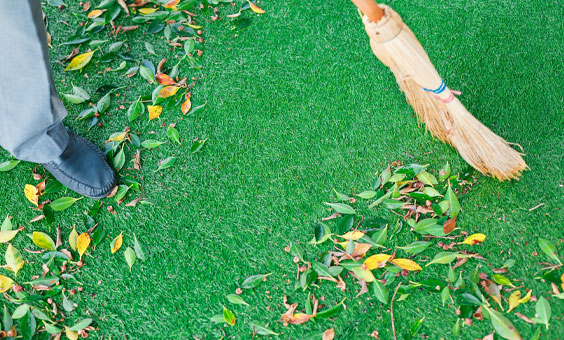Artificial grass care guide
You’ve finally made the move over to artificial grass — no more trudging up and down the garden cutting the lawn every week! However, a little light maintenance once a month can save you more time and trouble than none at all. Not only will it keep your lawn looking brand new for longer, it will also extend the lifespan of the grass — and of course, makes it much safer for children and pets.

Artificial grass maintenance made easy
Now that you’ve treated your garden (and yourself!) to artificial grass, read up on our easy ways to look after your new purchase.
Brushing artificial grass
- Lightly brush your new lawn on a regular basis (once a week or every other week) to remove any leaves or twigs — but remember to go gently, as if you use too much force you could end up misshaping the turf.
- The best brush for the job is a medium, soft bristle brush, which will be gentle enough on the grass while still doing its work.
- Brush the grass in the opposite direction of the artificial fibres.
Removing leaves from artificial grass
- Use a normal leaf blower for the quickest way to get rid of any leaves on artificial turf.
- If you can, remove your leaves on a day when the wind is blowing in the direction you want the leaves to go, or on a day with no breeze.
- Dry leaves are easier to remove with a blower than wet ones.
Cutting artificial grass
The best thing about artificial grass is that you never have to cut your lawn again! Other reasons why you should invest in artificial grass are:
- Save water and reduce your water bills
- More time to relax — no more cutting the grass every week!
- Safe for children and pets to play on
- Artificial grass drains quickly
- It won’t fade in the sunlight
- Looks lush and green all year round
- It’s long lasting and durable
Longing for a new lawn? Order some free artificial grass samples or pop into your local Carpetright store to help you decide today!
How to clean artificial grass
Contrary to popular belief, you won’t have to clean your artificial grass every day. Rainwater will wash away most surface dirt. However, we do recommend that you hose the lawn down once a week or once every other week to keep it looking its best.
Follow these few simple steps
- Regularly remove leaves and debris using a leaf blower, stiff brush or plastic rake.
- Trim hedges and trees often to limit the amount of leaves falling onto the lawn.
- Apply weed killer twice a year to the whole area to prevent weeds growing and to kill any stray ones.
- Use an artificial turf spray to clean away any urine from your pets. Sprinkle the area with baking soda before adding a diluted solution of water and vinegar to get rid of any odours.
How to remove stubborn stains from artificial grass
We’ve all been there — you’ve spilt tea, wine or ketchup — but how do you clean artificial grass? We’re here to help!
- Act quickly — and remove as much of the spillage as possible before it begins to harden.
- Soak up any liquids with a clean cloth, kitchen towel or (if you have some to hand) cat litter — all of these will absorb any liquid.
- If there is still a mark, mix a small amount of washing up liquid and lukewarm water together. Apply with a synthetic bristled brush or a clean cloth or sponge.
- Work the solution in between and around the stained fibres. Rinse the area thoroughly with water from a garden hose or watering can.
- If the spillage has hardened, you may need to carefully remove it using either a plastic spatula or plastic knife. You could also try using a toothbrush to gently brush the stain away.
How to get rid of weeds from artificial grass
If your garden wasn’t excavated thoroughly enough or your sub-base is contaminated, you may find that weeds can grow through drainage holes. You can invest in a quality weed barrier to try and prevent them coming through.
How to prevent weeds
- Use weed killer twice a year
- Rake grass regularly
- If you see a weed, pick it!
- Brush the lawn consistently to keep the fibres upright
How to maintain artificial grass all year round
During the autumn or winter months, the weather can result in debris being blown onto your garden, making it appear cluttered and unattractive. However, we have some top tips to keep your grass looking its best.
Winter weather
Winter conditions won’t affect our range of artificial grass — frost won’t damage it and it won’t snap or break either. However, if snow is stamped into the grass and an icy layer is created, leave it to melt naturally. If you try to remove this yourself you could damage the fibres.
Fire
We know it sounds obvious, but you must prevent any fire and any hot items such as ashes from a barbeque or fire pit, or cigarettes from falling into contact with artificial grass, as it can cause melting.
Heavy items
Yes, heavy items such as tables and chairs can be placed on your artificial lawn, however, you should use a type of castor under the legs to spread the weight out to prevent any damage to the artificial grass. Having large pieces of furniture can temporarily flatten your grass, but once you move whatever was in that spot, it should come back up if given enough time. Move furniture around every now and again. Be careful to not put metal furniture with sharp edges on artificial grass.
If your artificial grass looks a bit flat, you may be able to encourage it to stand up again using the following tips:
- Use a brush or rake to encourage the strands to stand up. Use a hard-bristled garden brush (avoid metal bristles).
- Brush or rake in one direction, going against the grain.
Artificial grass care tips
DO
Brush the grass regularly in the opposite direction of the artificial fibre
Regularly remove leaves and debris using a leaf blower, stiff brush or plastic rake
Trim hedges and trees often to limit the amount of leaves falling onto the lawn
Apply weed killer twice a year to the whole area to prevent weeds growing and to kill any stray ones
Use an artificial turf spray to clean away any urine from your pets
DON'T
Leave stains to settle — and don’t rub them!
Use barbeques, grills or fire pits
Leave equipment such as chainsaws or hedge trimmers on the turf after use
Use sharp objects on the grass
Have any motor vehicles on the artificial grass (wheelbarrows, bicycles and wheelchairs are all fine)
This guide should be able to answer all your questions and help make maintaining your new lawn easy. For anything else, get in touch with us today.
Is it time to upgrade your lawn?
Is your grass looking a little worse for wear? It may be time to invest in a new lawn that lasts longer. Take a look at our high-quality, low maintenance range of artificial grass and read our artificial grass buying guide for help on choosing the right one.



